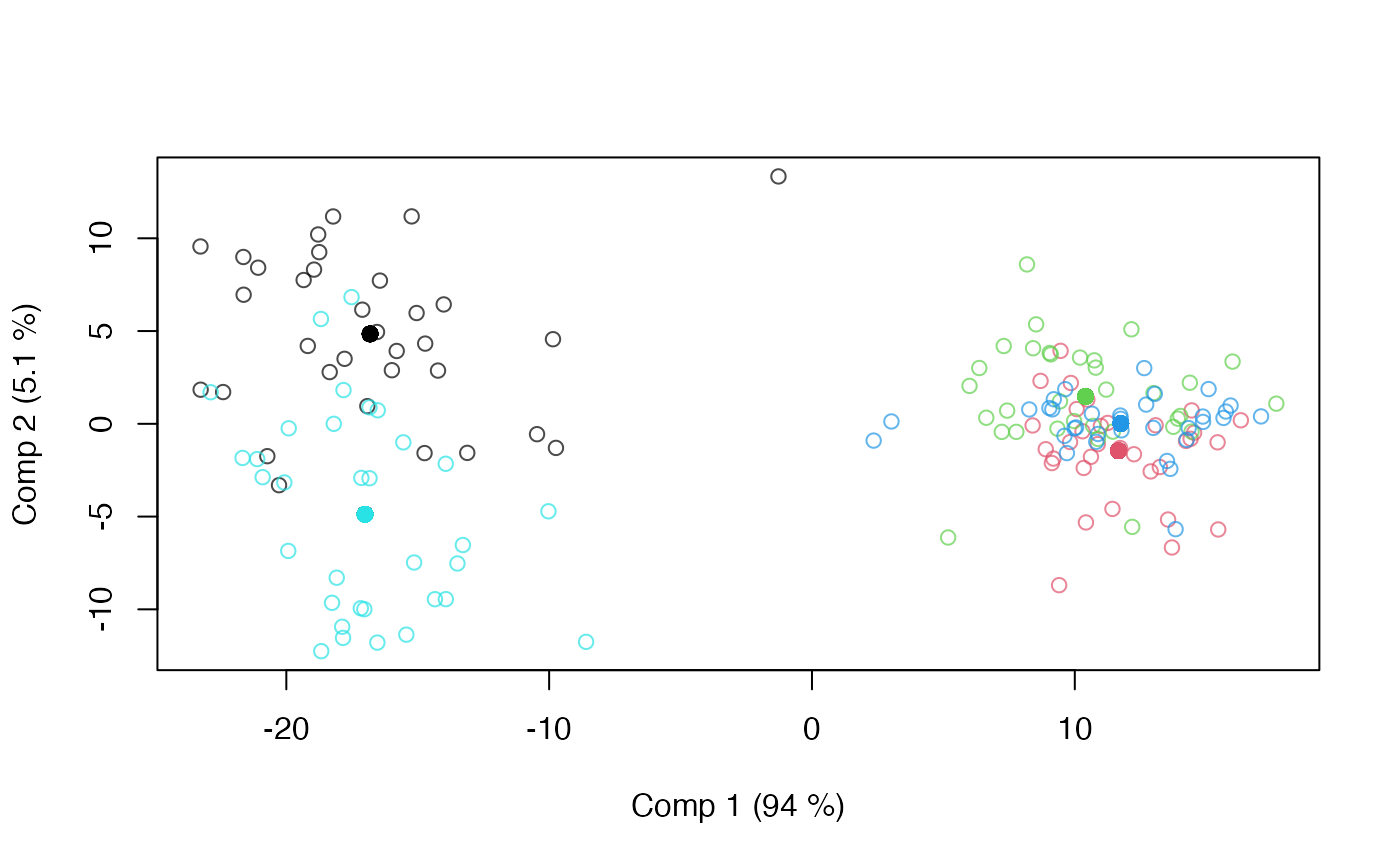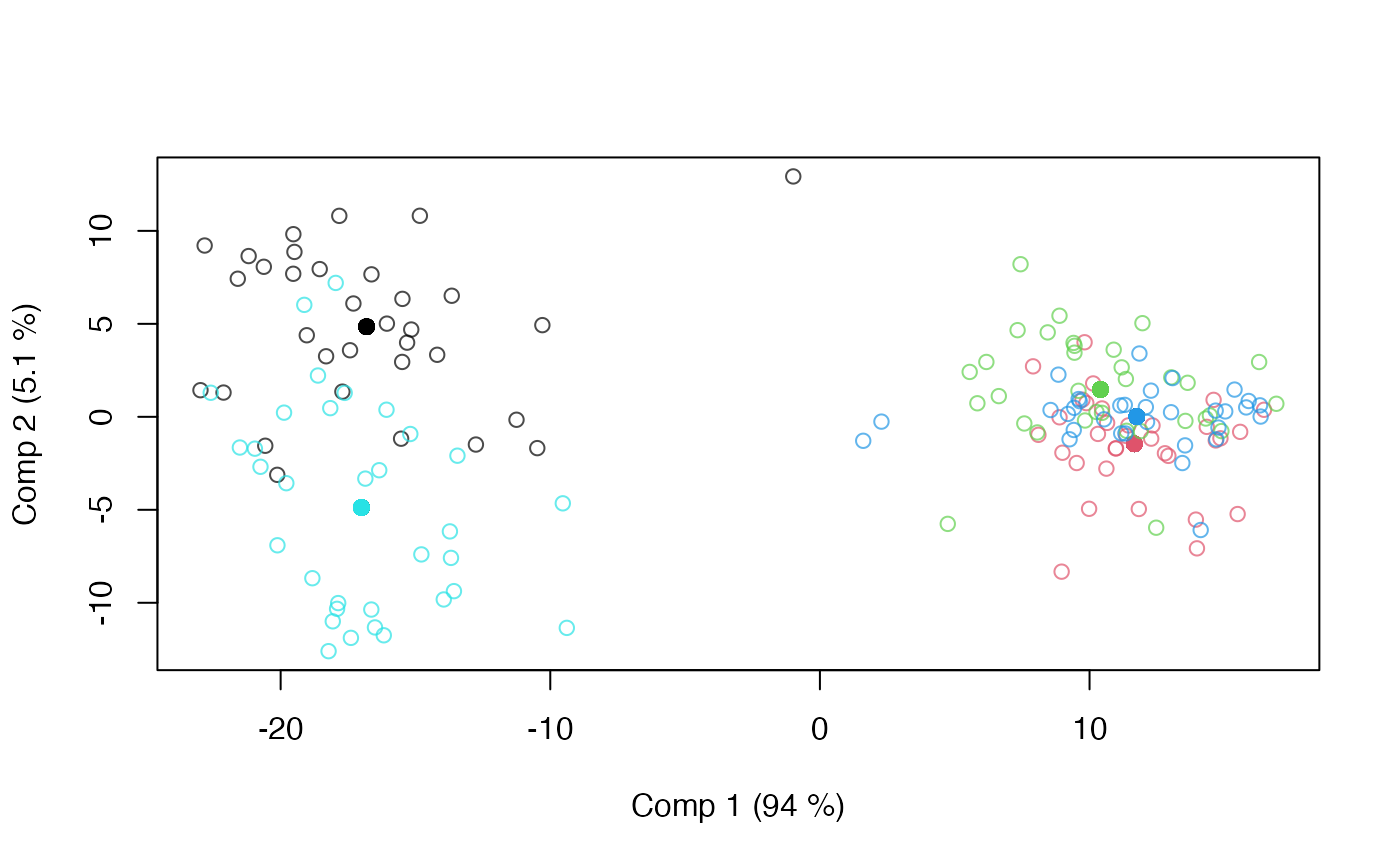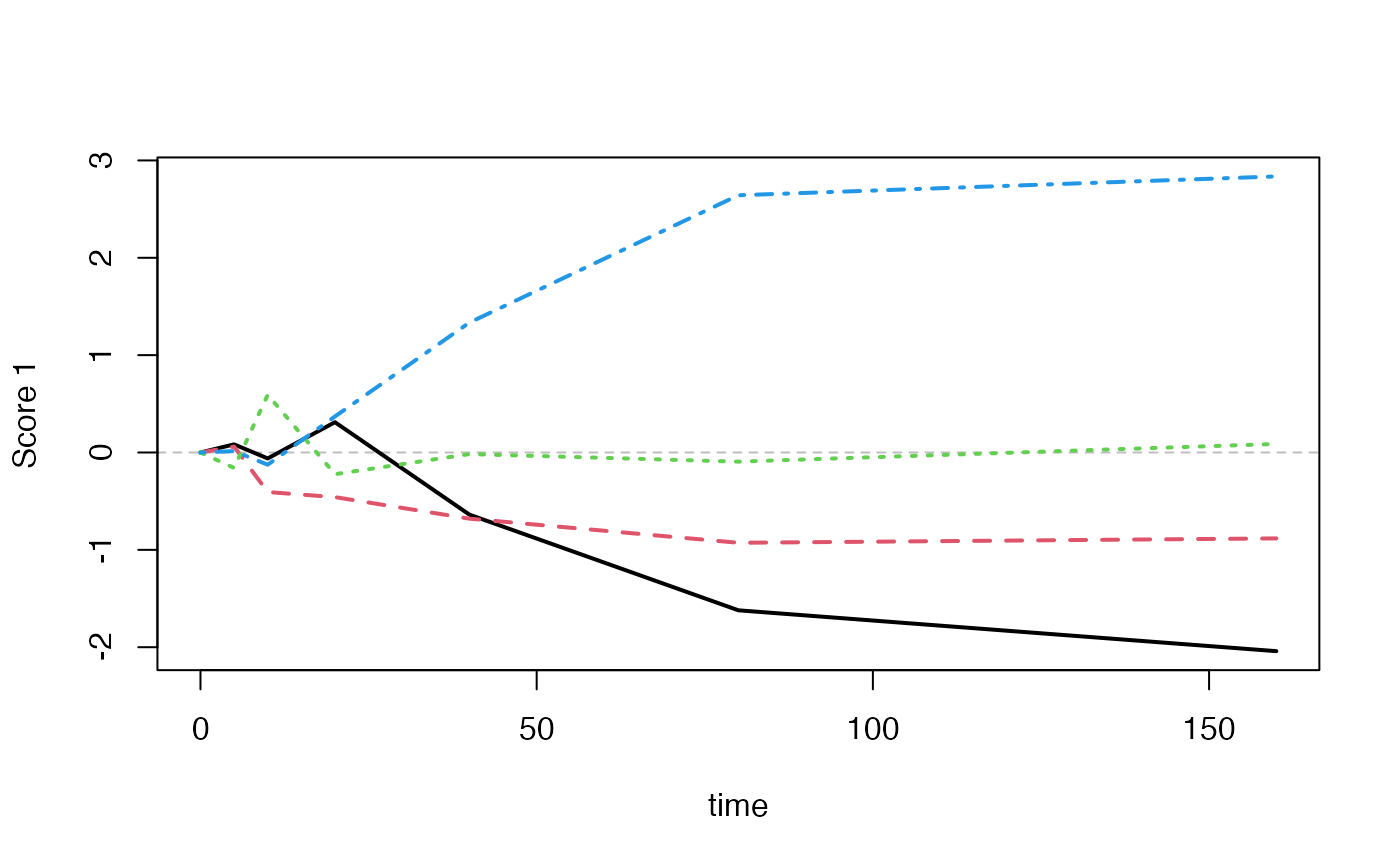This is a quite general and flexible implementation of ASCA.
Usage
asca(
formula,
data,
contrasts = "contr.sum",
permute = FALSE,
perm.type = c("approximate", "exact"),
...
)Arguments
- formula
Model formula accepting a single response (block) and predictors. See Details for more information.
- data
The data set to analyse.
- contrasts
Effect coding: "sum" (default = sum-coding), "weighted", "reference", "treatment".
- permute
Number of permutations to perform (default = 1000).
- perm.type
Type of permutation to perform, either "approximate" or "exact" (default = "approximate").
- ...
Additional arguments to
hdanova.
Value
An asca object containing loadings, scores, explained variances, etc. The object has
associated plotting (asca_plots) and result (asca_results) functions.
Details
ASCA is a method which decomposes a multivariate response according to one or more design
variables. ANOVA is used to split variation into contributions from factors, and PCA is performed
on the corresponding least squares estimates, i.e., Y = X1 B1 + X2 B2 + ... + E = T1 P1' + T2 P2' + ... + E.
This version of ASCA encompasses variants of LiMM-PCA, generalized ASCA and covariates ASCA. It includes
confidence ellipsoids for the balanced crossed-effect ASCA.
The formula interface is extended with the function r() to indicate random effects and comb() to indicate effects that should be combined. See Examples for use cases.
References
Smilde, A., Jansen, J., Hoefsloot, H., Lamers,R., Van Der Greef, J., and Timmerman, M.(2005). ANOVA-Simultaneous Component Analysis (ASCA): A new tool for analyzing designed metabolomics data. Bioinformatics, 21(13), 3043–3048.
Liland, K.H., Smilde, A., Marini, F., and Næs,T. (2018). Confidence ellipsoids for ASCA models based on multivariate regression theory. Journal of Chemometrics, 32(e2990), 1–13.
Martin, M. and Govaerts, B. (2020). LiMM-PCA: Combining ASCA+ and linear mixed models to analyse high-dimensional designed data. Journal of Chemometrics, 34(6), e3232.
See also
Main methods: asca, apca, limmpca, msca, pcanova, prc and permanova.
Workhorse function underpinning most methods: hdanova.
Extraction of results and plotting: asca_results, asca_plots, pcanova_results and pcanova_plots
Examples
# Load candies data
data(candies)
# Basic ASCA model with two factors
mod <- asca(assessment ~ candy + assessor, data=candies)
print(mod)
#> Anova Simultaneous Component Analysis fitted using 'lm' (Linear Model)
#> Call:
#> asca(formula = assessment ~ candy + assessor, data = candies)
# ASCA model with interaction
mod <- asca(assessment ~ candy * assessor, data=candies)
print(mod)
#> Anova Simultaneous Component Analysis fitted using 'lm' (Linear Model)
#> Call:
#> asca(formula = assessment ~ candy * assessor, data = candies)
# Result plotting for first factor
loadingplot(mod, scatter=TRUE, labels="names")
 scoreplot(mod)
scoreplot(mod)
 # No backprojection
scoreplot(mod, projections=FALSE)
# No backprojection
scoreplot(mod, projections=FALSE)
 # Spider plot
scoreplot(mod, spider=TRUE)
# Spider plot
scoreplot(mod, spider=TRUE)
 # ASCA model with compressed response using 5 principal components
mod.pca <- asca(assessment ~ candy + assessor, data=candies, pca.in=5)
# Mixed Model ASCA, random assessor
mod.mix <- asca(assessment ~ candy + r(assessor), data=candies)
scoreplot(mod.mix)
# ASCA model with compressed response using 5 principal components
mod.pca <- asca(assessment ~ candy + assessor, data=candies, pca.in=5)
# Mixed Model ASCA, random assessor
mod.mix <- asca(assessment ~ candy + r(assessor), data=candies)
scoreplot(mod.mix)
 # Mixed Model ASCA, REML estimation
mod.mix <- asca(assessment ~ candy + r(assessor), data=candies, REML=TRUE)
scoreplot(mod.mix)
# Mixed Model ASCA, REML estimation
mod.mix <- asca(assessment ~ candy + r(assessor), data=candies, REML=TRUE)
scoreplot(mod.mix)
 # Load Caldana data
data(caldana)
# Combining effects in ASCA
mod.comb <- asca(compounds ~ time + comb(light + time:light), data=caldana)
summary(mod.comb)
#> Anova Simultaneous Component Analysis fitted using 'lm' (Linear Model)
#> - SS type II, sum coding, restricted model, least squares estimation
#> Sum.Sq. Expl.var.(%)
#> time 154.58 9.69
#> light+time:light 349.64 21.92
#> Residuals 1091.14 68.39
timeplot(mod.comb, factor="light", time="time", comb=2)
# Load Caldana data
data(caldana)
# Combining effects in ASCA
mod.comb <- asca(compounds ~ time + comb(light + time:light), data=caldana)
summary(mod.comb)
#> Anova Simultaneous Component Analysis fitted using 'lm' (Linear Model)
#> - SS type II, sum coding, restricted model, least squares estimation
#> Sum.Sq. Expl.var.(%)
#> time 154.58 9.69
#> light+time:light 349.64 21.92
#> Residuals 1091.14 68.39
timeplot(mod.comb, factor="light", time="time", comb=2)
 # Permutation testing
mod.perm <- asca(assessment ~ candy * assessor, data=candies, permute=TRUE)
summary(mod.perm)
#> Anova Simultaneous Component Analysis fitted using 'lm' (Linear Model)
#> - SS type II, sum coding, restricted model, least squares estimation, 1000 permutations
#> Sum.Sq. Expl.var.(%) p-value
#> candy 33416.66 74.48 0
#> assessor 1961.37 4.37 0
#> candy:assessor 3445.73 7.68 0
#> Residuals 6043.52 13.47 NA
# Permutation testing
mod.perm <- asca(assessment ~ candy * assessor, data=candies, permute=TRUE)
summary(mod.perm)
#> Anova Simultaneous Component Analysis fitted using 'lm' (Linear Model)
#> - SS type II, sum coding, restricted model, least squares estimation, 1000 permutations
#> Sum.Sq. Expl.var.(%) p-value
#> candy 33416.66 74.48 0
#> assessor 1961.37 4.37 0
#> candy:assessor 3445.73 7.68 0
#> Residuals 6043.52 13.47 NA